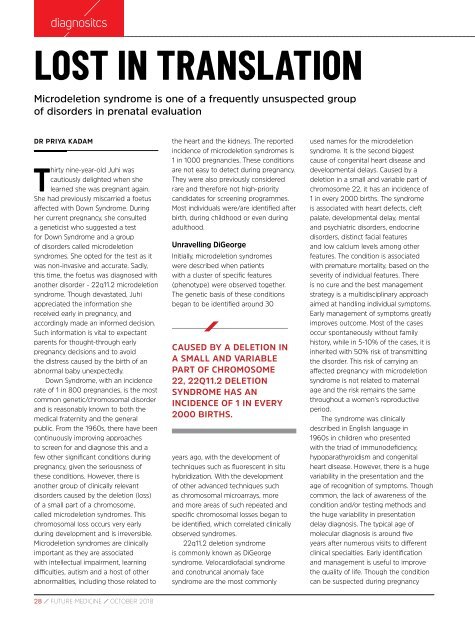You also want an ePaper? Increase the reach of your titles
YUMPU automatically turns print PDFs into web optimized ePapers that Google loves.
diagnositcs<br />
LOST IN TRANSLATION<br />
Microdeletion syndrome is one of a frequently unsuspected group<br />
of disorders in prenatal evaluation<br />
DR PRIYA KADAM<br />
Thirty nine-year-old Juhi was<br />
cautiously delighted when she<br />
learned she was pregnant again.<br />
She had previously miscarried a foetus<br />
affected with Down Syndrome. During<br />
her current pregnancy, she consulted<br />
a geneticist who suggested a test<br />
for Down Syndrome and a group<br />
of disorders called microdeletion<br />
syndromes. She opted for the test as it<br />
was non-invasive and accurate. Sadly,<br />
this time, the foetus was diagnosed with<br />
another disorder - 22q11.2 microdeletion<br />
syndrome. Though devastated, Juhi<br />
appreciated the information she<br />
received early in pregnancy, and<br />
accordingly made an informed decision.<br />
Such information is vital to expectant<br />
parents for thought-through early<br />
pregnancy decisions and to avoid<br />
the distress caused by the birth of an<br />
abnormal baby unexpectedly.<br />
Down Syndrome, with an incidence<br />
rate of 1 in 800 pregnancies, is the most<br />
common genetic/chromosomal disorder<br />
and is reasonably known to both the<br />
medical fraternity and the general<br />
public. From the 1960s, there have been<br />
continuously improving approaches<br />
to screen for and diagnose this and a<br />
few other significant conditions during<br />
pregnancy, given the seriousness of<br />
these conditions. However, there is<br />
another group of clinically relevant<br />
disorders caused by the deletion (loss)<br />
of a small part of a chromosome,<br />
called microdeletion syndromes. This<br />
chromosomal loss occurs very early<br />
during development and is irreversible.<br />
Microdeletion syndromes are clinically<br />
important as they are associated<br />
with intellectual impairment, learning<br />
difficulties, autism and a host of other<br />
abnormalities, including those related to<br />
the heart and the kidneys. The reported<br />
incidence of microdeletion syndromes is<br />
1 in 1000 pregnancies. These conditions<br />
are not easy to detect during pregnancy.<br />
They were also previously considered<br />
rare and therefore not high-priority<br />
candidates for screening programmes.<br />
Most individuals were/are identified after<br />
birth, during childhood or even during<br />
adulthood.<br />
Unravelling DiGeorge<br />
Initially, microdeletion syndromes<br />
were described when patients<br />
with a cluster of specific features<br />
(phenotype) were observed together.<br />
The genetic basis of these conditions<br />
began to be identified around 30<br />
CAUSED BY A DELETION IN<br />
A SMALL AND VARIABLE<br />
PART OF CHROMOSOME<br />
22, 22Q11.2 DELETION<br />
SYNDROME HAS AN<br />
INCIDENCE OF 1 IN EVERY<br />
2000 BIRTHS.<br />
years ago, with the development of<br />
techniques such as fluorescent in situ<br />
hybridization. With the development<br />
of other advanced techniques such<br />
as chromosomal microarrays, more<br />
and more areas of such repeated and<br />
specific chromosomal losses began to<br />
be identified, which correlated clinically<br />
observed syndromes.<br />
22q11.2 deletion syndrome<br />
is commonly known as DiGeorge<br />
syndrome. Velocardiofacial syndrome<br />
and conotruncal anomaly face<br />
syndrome are the most commonly<br />
used names for the microdeletion<br />
syndrome. It is the second biggest<br />
cause of congenital heart disease and<br />
developmental delays. Caused by a<br />
deletion in a small and variable part of<br />
chromosome 22, it has an incidence of<br />
1 in every 2000 births. The syndrome<br />
is associated with heart defects, cleft<br />
palate, developmental delay, mental<br />
and psychiatric disorders, endocrine<br />
disorders, distinct facial features<br />
and low calcium levels among other<br />
features. The condition is associated<br />
with premature mortality, based on the<br />
severity of individual features. There<br />
is no cure and the best management<br />
strategy is a multidisciplinary approach<br />
aimed at handling individual symptoms.<br />
Early management of symptoms greatly<br />
improves outcome. Most of the cases<br />
occur spontaneously without family<br />
history, while in 5-10% of the cases, it is<br />
inherited with 50% risk of transmitting<br />
the disorder. This risk of carrying an<br />
affected pregnancy with microdeletion<br />
syndrome is not related to maternal<br />
age and the risk remains the same<br />
throughout a women’s reproductive<br />
period.<br />
The syndrome was clinically<br />
described in English language in<br />
1960s in children who presented<br />
with the triad of immunodeficiency,<br />
hypoparathyroidism and congenital<br />
heart disease. However, there is a huge<br />
variability in the presentation and the<br />
age of recognition of symptoms. Though<br />
common, the lack of awareness of the<br />
condition and/or testing methods and<br />
the huge variability in presentation<br />
delay diagnosis. The typical age of<br />
molecular diagnosis is around five<br />
years after numerous visits to different<br />
clinical specialties. Early identification<br />
and management is useful to improve<br />
the quality of life. Though the condition<br />
can be suspected during pregnancy<br />
28 / FUTURE MEDICINE / <strong>OCTOBER</strong> <strong>2018</strong>


















